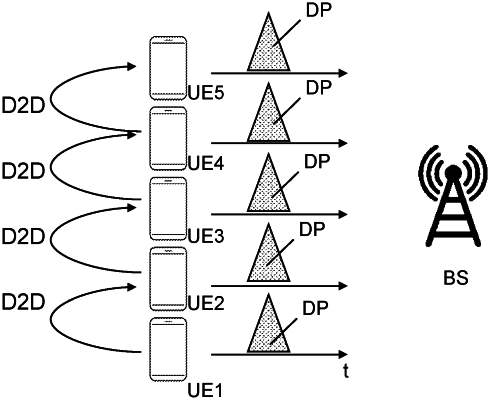| CPC H04W 56/001 (2013.01) [H04W 12/033 (2021.01); H04W 52/0212 (2013.01); H04W 76/14 (2018.02); H04W 88/04 (2013.01); H04W 92/18 (2013.01)] | 11 Claims |

|
1. A method for data transmission from a first user equipment to a base station of a cellular network, the method comprising, by the first user equipment:
transmitting at least one data packet to at least one second user equipment via a device-to-device communication channel;
instructing the at least one second user equipment to transmit the at least one data packet to the base station time-synchronized with transmission of the at least one data packet by the first user equipment to the base station such that signals related to transmission of the at least one data packet by the first user equipment and the at least one second user equipment are recognized by the base station as a transmit-diversity emission;
transmitting the at least one data packet to the base station time-synchronized with transmission of the at least one data packet by the at least one second user equipment to the base station;
receiving from the base station an indication about an imbalance of time synchronization between transmission of the at least one data packet to the base station by the first user equipment and transmission of the at least one data packet to the base station by the at least one second user equipment; and
upon receipt of the indication:
stalling the transmission of the at least one data packet to the base station;
indicating the at least one second user equipment to stall the transmission of the at least one data packet to the base station;
carrying out time synchronization improvement measures between the first user equipment and the at least one second user equipment;
re-negotiating with the base station a new timing conditions for the transmission of the at least one data packet, the new timing conditions comprise a time for starting the transmission of the at least one data packet to the base station;
sharing the new timing conditions with the at least one second user equipment via the device-to-device communication channel;
instructing the at least one second user equipment to continue the transmission of the at least one data packet to the base station time-synchronized with the transmission of the at least one data packet by the first user equipment to the base station according to the new timing conditions; and
continuing the transmission of the at least one data packet to the base station time-synchronized with the transmission of the at least one data packet by the at least one second user equipment to the base station according to the new timing conditions;
wherein the first user equipment and the at least one second user equipment camp on the base station under coverage enhancement conditions.
|